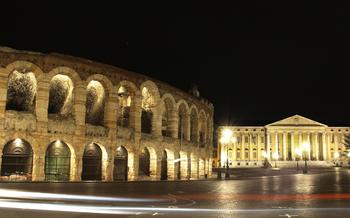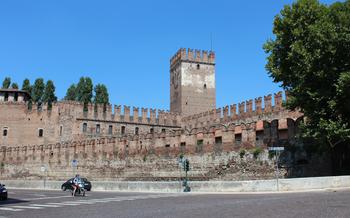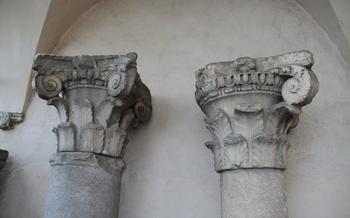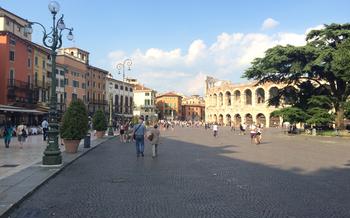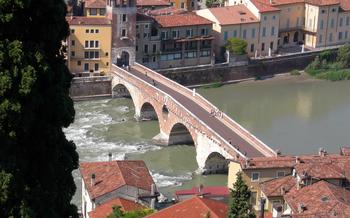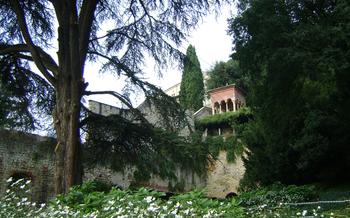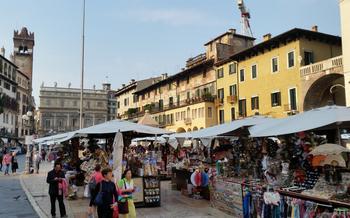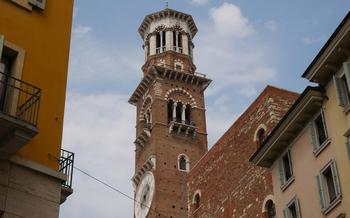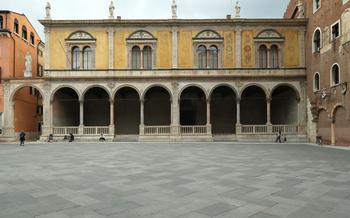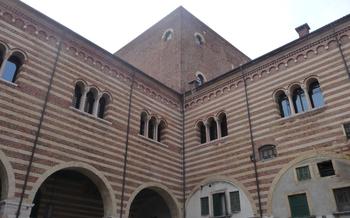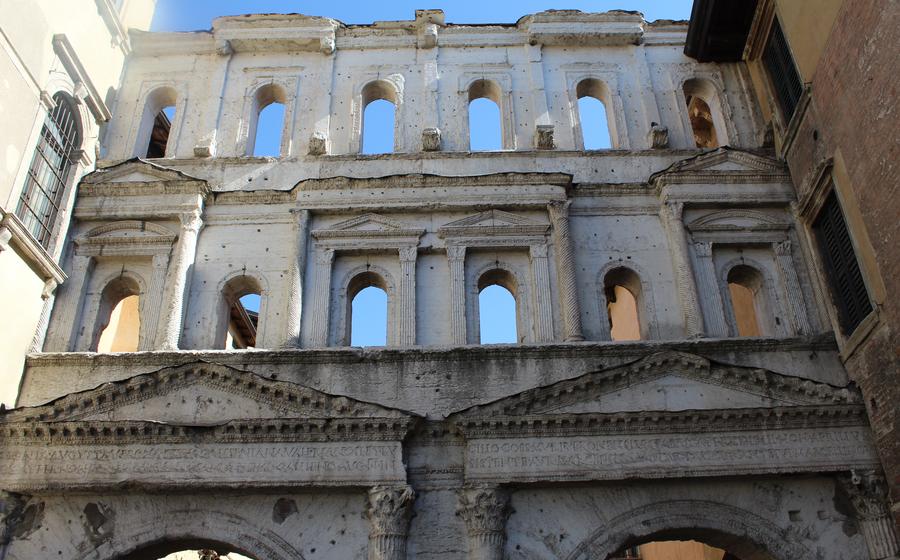
Porta Borsari
- Verona, City of History and Romance:
- Porta Borsari: A Historical Gateway
- Location and Accessibility
- Exploring the Arches
- Defensive Structures
- Roman Legacy
- Porta Borsari Today
- UNESCO World Heritage Site:
- Local Legends and Traditions
- Cultural and Artistic Significance
- Shopping and Dining Nearby:
- Photo Opportunities
- Guided Tours and Audio Guides:
- Insider Tip:
Verona, City of History and Romance:
Verona, a captivating city in northeastern Italy, is a treasure trove of history, art, and romance.
Porta Borsari: A Historical Gateway
The Porta Borsari, also known as the Porta dei Borsari, is one of the most impressive and well-preserved ancient gateways in Verona. Constructed in the 1st century AD during the Roman Empire, it stands as a testament to the city's rich history and architectural heritage. The gate's name, derived from the Latin word "bursarii," refers to the tax collectors who once operated there, collecting duties on goods entering the city. The Porta Borsari served as a vital entry point for trade and travel, connecting Verona to the rest of the Roman Empire.
The Porta Borsari is a magnificent example of Roman engineering and architecture. It features two large arches for vehicular traffic, flanked by two smaller pedestrian arches on either side. The gate's sturdy construction, with its massive stone blocks and intricate brickwork, has withstood the test of time and remains intact to this day. The arches are adorned with decorative elements, including moldings, friezes, and inscriptions, which add to the gate's grandeur and historical significance.
Location and Accessibility
The Porta Borsari is ideally situated within the ancient city walls of Verona, offering easy access to a plethora of captivating landmarks. To reach this architectural gem, visitors can stroll through the enchanting streets of the city center, immersing themselves in the vibrant atmosphere and admiring the surrounding medieval architecture. Alternatively, public transportation provides a convenient option, with several bus routes stopping nearby. For those arriving by car, ample parking is available in the vicinity, ensuring a hassle-free visit. Moreover, the Porta Borsari is fully accessible to visitors with disabilities, featuring wheelchair ramps and accessible pathways, allowing everyone to marvel at its grandeur.
Exploring the Arches
The Porta Borsari's two main arches are impressive in size and shape. The larger central arch, towering over the smaller pedestrian arches, allows for the passage of carts and carriages. Its rounded shape and sturdy construction demonstrate the engineering prowess of the ancient Romans.
Flanking the main arch are two smaller pedestrian arches, each featuring a lower, more intimate passageway. These smaller arches provided convenient access for foot traffic, allowing locals and visitors to enter or exit the city without obstructing the flow of goods and vehicles through the main arch.
The arches of the Porta Borsari are further adorned with intricate decorative elements and carvings. Acanthus leaves, a common motif in Roman architecture, are delicately carved into the stone, adding a touch of elegance and artistry to the gate's otherwise robust structure.
Inscriptions and dedications can also be found on the arches, providing historical context and insights into the gate's construction and purpose. One such inscription, located above the main arch, commemorates the restoration of the gate in the 3rd century AD by the emperor Gallienus.
Defensive Structures
The Porta Borsari's sturdy construction, massive doors, and imposing guard towers speak to its defensive capabilities. These features were crucial in protecting Verona from invasions and attacks. The thick walls and solid construction of the gate provided a formidable barrier against enemy forces. The massive doors, often reinforced with iron and studded with bolts, could be securely shut to prevent entry. The guard towers, positioned on either side of the gate, allowed defenders to keep watch for approaching enemies and launch projectiles or boiling liquids to repel attacks. Throughout its history, the Porta Borsari has withstood numerous sieges and battles, serving as a testament to its defensive strength and resilience. In the 13th century, the gate successfully resisted an attack by the troops of Ezzelino III da Romano, a powerful warlord who had conquered much of northern Italy. The gate's strategic location and robust defenses made it a key element in Verona's ability to withstand attacks and maintain its independence.
Roman Legacy
The Porta Borsari stands as a testament to the enduring legacy of Roman engineering and architecture in Verona. Its construction reflects the advanced techniques and materials employed by the Romans, showcasing their mastery of arch and concrete construction. The gate's design incorporates elements of Roman architectural styles, characterized by symmetry, proportion, and the use of decorative elements. The Porta Borsari serves as a reminder of the significant influence of Roman civilization on the city of Verona, leaving a lasting imprint on its urban fabric and cultural heritage. Visitors can explore other Roman landmarks and ruins in Verona, such as the Verona Arena, the Roman Theater, and the Archeological Museum, to gain a deeper understanding of the city's rich Roman past.
Porta Borsari Today
Despite the passage of time and the many changes Verona has undergone, the Porta Borsari remains remarkably well-preserved, thanks to ongoing restoration efforts. In recent years, the gate has been transformed into a popular tourist attraction, drawing visitors from around the world who come to admire its architectural beauty and historical significance. Today, the Porta Borsari stands as a beloved landmark for both locals and visitors, symbolizing the enduring legacy of ancient Verona.
Throughout the year, the gate hosts a variety of events, exhibitions, and performances that showcase its cultural and historical significance. Visitors can attend concerts, art shows, and historical reenactments that bring the gate's past to life. The Porta Borsari is also a popular venue for weddings and other special events, offering a unique and romantic setting for these memorable occasions.
Admission to the Porta Borsari is free of charge, and it is open to the public during daylight hours. Guided tours of the gate are available for a small fee, providing visitors with an in-depth look at its history and architecture. Visitors can also explore the gate at their own pace using audio guides or smartphone apps that offer self-guided tours with historical commentary.
UNESCO World Heritage Site:
In recognition of its exceptional cultural and historical value, the Porta Borsari has been designated as a UNESCO World Heritage Site. This prestigious recognition is a testament to the gate's significance as an outstanding example of Roman engineering and architecture. The Porta Borsari meets several of the criteria outlined by UNESCO for World Heritage status:
-
Authenticity: The gate has retained its original form and structure, with minimal alterations or modifications over the centuries.
-
Integrity: The Porta Borsari has survived intact, despite its age and the various historical events that have taken place in Verona.
-
Outstanding Universal Value: The gate's architectural features, defensive elements, and historical associations make it a unique and remarkable monument of Roman urban planning and engineering.
Visitors to Verona can explore several other UNESCO World Heritage Sites, including the entire historic city center. The Arena di Verona, with its well-preserved Roman amphitheater, and the Castelvecchio, a medieval castle that now houses an art museum, are among the city's most notable UNESCO-listed landmarks. By visiting these sites, travelers can gain a deeper understanding of Verona's rich cultural heritage and its enduring legacy as a city of historical significance.
Local Legends and Traditions
The Porta Borsari is not only a historical landmark but also a source of local legends and traditions that have been passed down through generations. One popular tale tells of a hidden treasure buried beneath the gate, said to be the lost wealth of a wealthy Roman family. Treasure hunters have searched for centuries, but the treasure remains undiscovered, adding to the gate's mystique.
Another legend speaks of a ghost that haunts the Porta Borsari, the spirit of a Roman soldier who was killed defending the city. Visitors have reported seeing the ghost's apparition, clad in armor, patrolling the gate at night.
These legends and traditions are deeply rooted in the local culture and add to the Porta Borsari's charm and allure. They remind visitors that the gate has stood for centuries, witnessing countless stories of love, loss, and triumph.
Cultural and Artistic Significance
Beyond its historical and architectural value, the Porta Borsari holds significant cultural and artistic importance. The gate has served as a backdrop for numerous films, artworks, and literary works set in Verona, captivating audiences with its timeless beauty and evocative aura. Renowned filmmakers, such as Franco Zeffirelli, have chosen the Porta Borsari as a setting for their cinematic masterpieces, bringing the gate's grandeur to the silver screen. Artists have been inspired by its striking form and intricate details, capturing its essence in paintings, sculptures, and sketches that adorn galleries and museums in Verona.
Moreover, the Porta Borsari has played a pivotal role in shaping the literary landscape of Verona. It is mentioned in Shakespeare's iconic tragedy, Romeo and Juliet, as one of the locations where the star-crossed lovers meet and exchange their vows. This literary connection has immortalized the gate, making it a symbol of love and romance for generations of readers and theatergoers worldwide.
Shopping and Dining Nearby:
When exploring the Porta Borsari, take the chance to delve into Verona's vibrant culinary and shopping scenes, which offer a wide array of experiences. In the vicinity of the gate, you'll find charming boutiques selling exquisite souvenirs, antiques, and traditional Italian products. Discover unique treasures that reflect the city's rich heritage, from hand-painted ceramics to intricate glasswork.
For a culinary adventure, savor the authentic flavors of Italian cuisine at nearby restaurants and cafes. Indulge in mouthwatering pasta dishes, succulent grilled meats, and delectable desserts that showcase the region's culinary prowess. Don't miss the chance to try local specialties such as risotto all'Amarone, a creamy rice dish infused with the renowned Amarone wine, or the tender tortellini di Valeggio, filled with a flavorful meat and cheese mixture.
For an immersive culinary experience, join a food tour that takes you through the city's bustling markets, where you can sample fresh produce, local cheeses, and cured meats. Engage with passionate vendors and learn about the culinary traditions that make Verona a foodie's paradise.
Photo Opportunities
The Porta Borsari offers ample opportunities for capturing stunning photographs. With its imposing arches, intricate carvings, and strategic location, the gate presents a picturesque subject for photography enthusiasts.
For the best shots, position yourself directly in front of the gate to capture its full grandeur. Experiment with different angles and perspectives to emphasize its architectural details. The morning or late afternoon light casts a warm glow on the stone, enhancing the gate's beauty.
Incorporate the surrounding elements into your composition, such as the bustling street life, passing cyclists, or the nearby Piazza delle Erbe. These elements add a sense of dynamism and context to your photographs.
If you're using a smartphone, utilize its camera features like HDR or portrait mode to capture the gate's intricate details. For Instagram enthusiasts, the Porta Borsari is a popular spot for capturing creative and shareable images.
Consider joining a photography tour or workshop focused on Verona's architecture to learn from experienced photographers and discover hidden photo spots around the Porta Borsari. These tours often provide insights into the gate's history and cultural significance, enriching your photographic experience.
Guided Tours and Audio Guides:
To delve deeper into the rich history and significance of the Porta Borsari and Verona's historic center, guided tours are highly recommended. Professional guides, often fluent in multiple languages, offer insightful commentary and anecdotes that bring the past to life. These tours typically cover the main landmarks, including the Verona Arena, Juliet's House, and the Piazza delle Erbe, providing a comprehensive exploration of the city's heritage.
For those who prefer a self-guided experience, audio guides or smartphone apps offer a convenient alternative. These guides provide detailed historical information, allowing visitors to explore at their own pace. Reputable tour operators and guides can be found online or through local tourism offices. Booking tours in advance, especially during peak tourist season, is advisable to avoid disappointment.
Insider Tip:
Venture beyond the main arches of the Porta Borsari to discover a hidden gem – the small, secluded courtyard known as the Cortile del Mercato Vecchio. Once a bustling marketplace, this tranquil spot is now home to charming cafes and shops tucked away from the tourist crowds. Take a moment to relax here, sip on a traditional Italian coffee, and soak in the atmosphere of this hidden oasis. As you sit amidst the ancient walls, imagine the vibrant energy of the market that once filled this space, echoing the rich history of the Porta Borsari and the city of Verona.
